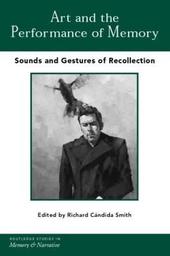
|
Art and the Performance of Memory: Sounds and Gestures of Recollection
Hardback
Main Details
| Title |
Art and the Performance of Memory: Sounds and Gestures of Recollection
|
| Authors and Contributors |
Edited by Richard Candida Smith
|
| Series | Routledge Studies in Memory and Narrative |
|---|
| Series part Volume No. |
v.9
|
| Physical Properties |
| Format:Hardback | | Pages:304 | | Dimensions(mm): Height 234,Width 156 |
|
| Category/Genre | Theory of art
Dance and other performing arts |
|---|
| ISBN/Barcode |
9780415277969
|
| Classifications | Dewey:306.484 |
|---|
| Audience | | Tertiary Education (US: College) | | Professional & Vocational | |
|---|
| Illustrations |
4 black & white tables
|
|
Publishing Details |
| Publisher |
Taylor & Francis Ltd
|
| Imprint |
Routledge
|
| Publication Date |
27 June 2002 |
| Publication Country |
United Kingdom
|
Description
This book investigates the role that the visual and performing arts play in our experience and understanding of the past. Expanding upon longstanding concerns in cultural history about the relation of text and image, the book highlights the distinction between enactive and cognitive memory and the implications of this for artists and their publics. The essays highlight the role of oral history in the documentation of the visual and performing arts. Contributors are drawn from a range of backgrounds, including art and architectural history, film, theatre and performance studies, social and cultural history. Blending theory and case study, they cover subjects such as: * The response of artists to the South African Truth and Reconciliation Commission, violence in Columbia and Mexico and the Balkan Wars * The circuit of sexual desire in contemporary art and photography * Sites of collective and personal memory, including the internet, the urban landscape, family photographs and hiphop. Stressing the relation of media to the formation of collective memory, the volume explores how media intertextuality creates overlapping repertoires for understanding the past and the present. Scholars of art history, media and cultural studies, literature and performance studies will all find this work a valuable resource.
|